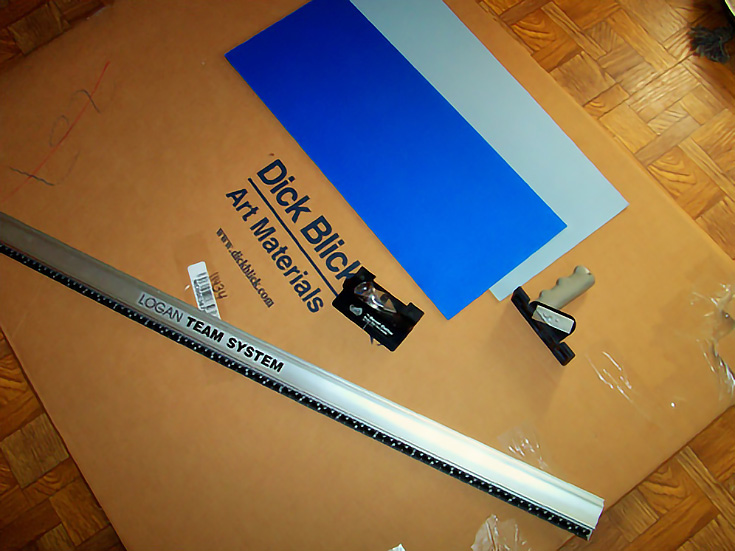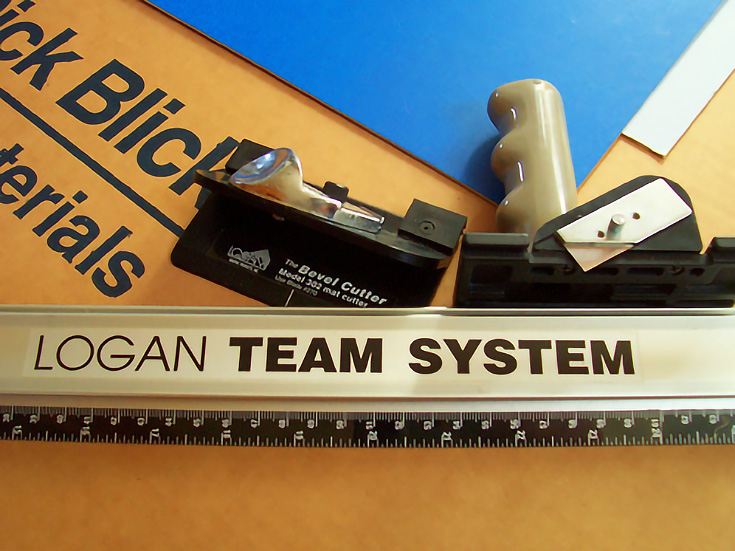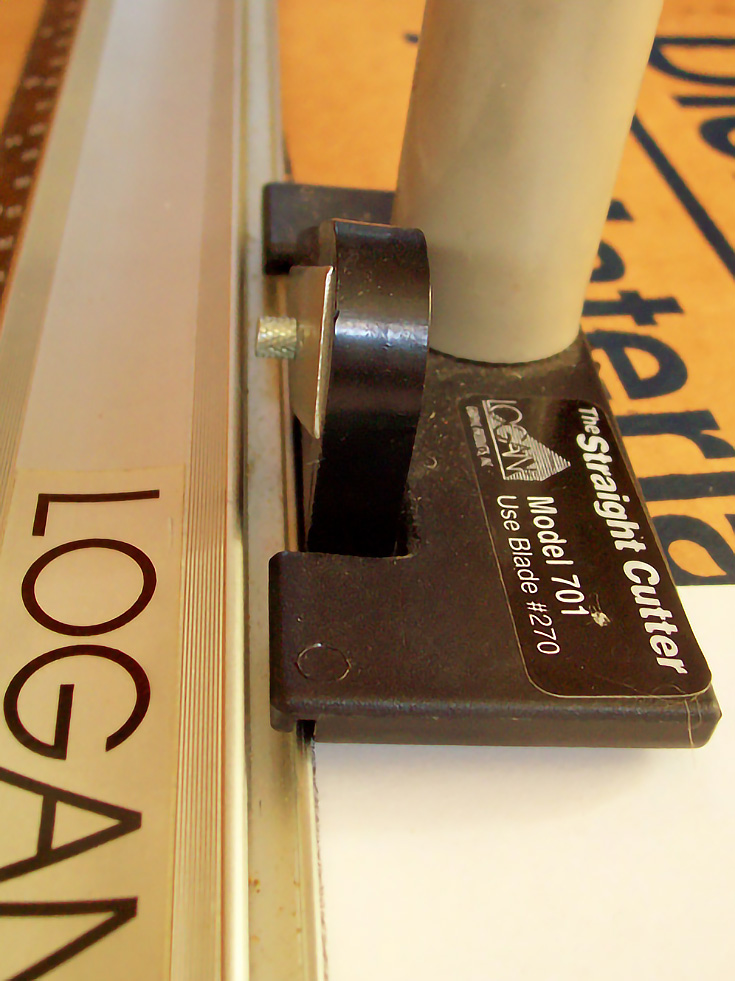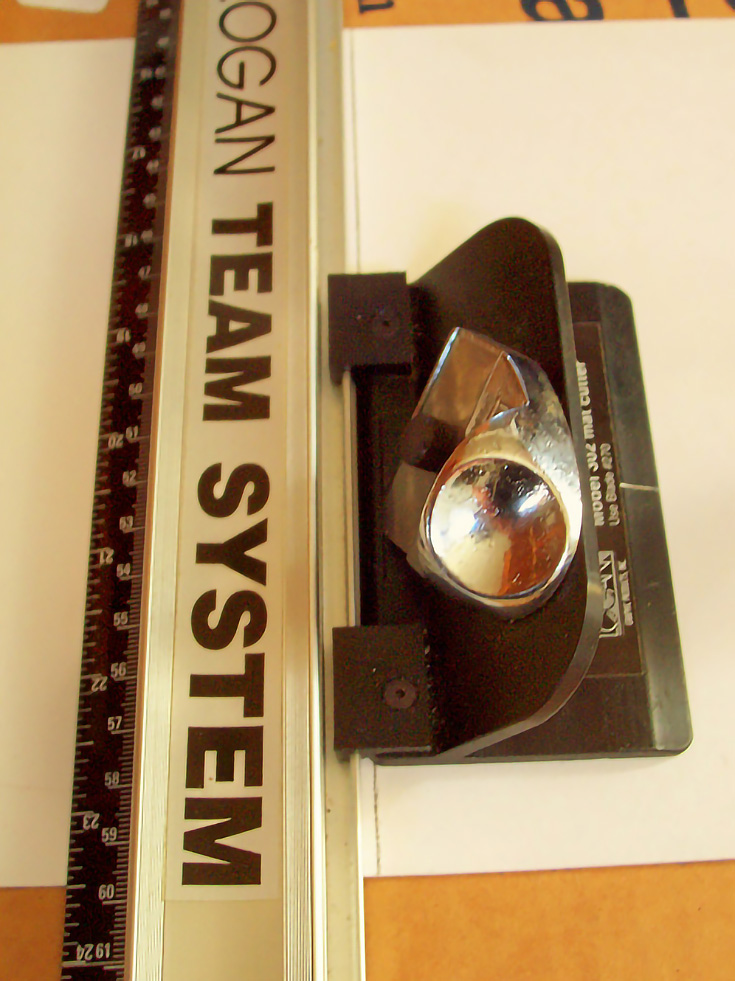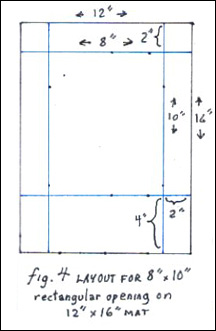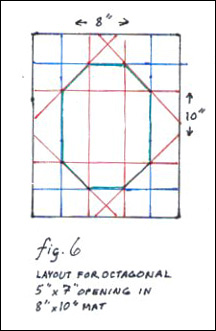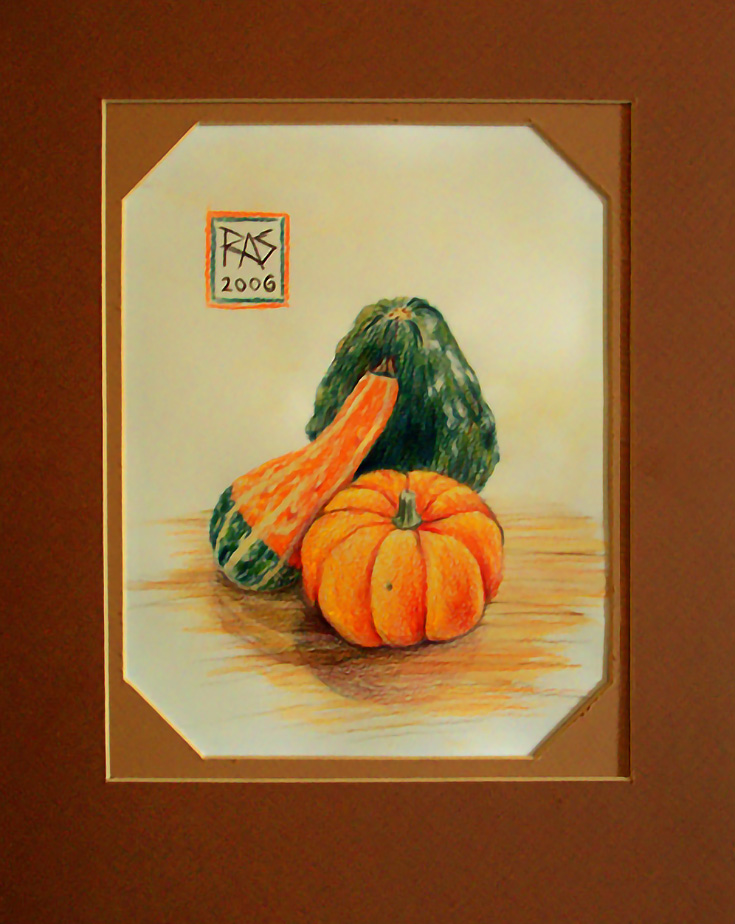I started cutting my own mats in the 1980s because I often drew in unusual sizes and it cost too much to have specialty mats cut at a store.
My first investment in mat cutting was a Logan Compact mat cutter, but when Blick put the Logan Team System 2 on sale in 2004, I replaced my old cutter with something much simpler—and found that it’s just as easy to use.
The Logan Team System 2 mat cutter is really a bare-bones setup. You get a 40" guide rail and a push-type beveled cutting head . That’s it.
I also bought a pull-type straight cutting head for about $20 to go with it so that I could cut mat boards into sections before cutting the openings.
The key to using this Team System 2 mat cutter is to first mark up your mat board exactly like you’ll be cutting it using a grid ruler , triangle, and pencil . Getting perfect 90 degree angles isn’t hard with those two tools, although I’ve found that measuring is easiest with a clear grid ruler that also has a scale for centering
Many types of clear rulers are available in craft stores, especially for doing quilting. Those are often heavy, 1/8" thick clear grid rulers which work great for cutting mats because you can check the angles through the ruler.
Once you’ve got your tools, some mat board, and some art to mat, you’re ready to begin. Find a large table (at least 40" long) or simply use the floor and lay down some thick corrugated cardboard to catch any scratches that go through the mat board.
If you’re working on a short pile carpet you don’t really need the cardboard, but if you do work on a table or hardwood floor it’s good to save the flat boxes that your mat boards (or full sheets of watercolor paper) come in as a cutting surface.
When my cutting surface is down, I draw out whatever exterior dimensions I need on the back of the mat board in pencil. I’ll use my ruler and sometimes the guide rail itself as a bigger ruler—but I always check the angles with my clear grid ruler when using the guide rail as a super yardstick.
You might want to invest in a good cutting board with a grid, as it makes checking angles easier. Sewing shops and craft stores carry them as well as art stores.
When my dimensions are finished, I connect the straight cutting head (shown above) to the guide rail.
Notice that I’ve lined up the guide rail so that my pencil line is just visible as I cut. That will give me a cut right down the middle of my penciled mark. (The beveled cutting head works a bit differently, but I’ll explain that later.)
This cutting head has two hooks that slide onto a ridge on the guide rail. I pop it in above the mat board and lean hard on the guide rail before starting my cut. When I’m on the floor, I generally put one knee and my left hand on the guide rail, putting a fair amount of weight on my left hand while pulling the cutting head with my right hand.
If you’re doing a long cut, you may want to have a friend or family member come hold down the guide rail at other intervals so that it’s more secure. Since it’s not mounted to a board, it can slip if you don’t have it secured by someone leaning on it.
And as you cut, you’ll want to focus most of your efforts on keeping the guide rail steady. . . because wherever the rail goes, so will the cutter.
Once the outer edges of my mat are cut (that’s the easy part) I put away the straight cutter head and get ready to mark up the inside opening which I’ll cut with the bevel cutter (shown below).
Now, I’m very fond of doing double mats and fancy mats, but there are any number of designs you can create. Proportions can vary, too, so you can leave more mat at the bottom if you’d like (or the top or sides). That’s one of the fun things about designing your own mats.
Remember that your inner cuts should overlap at least 1/4" on each side of your artwork. If you paint right to the edge of watercolor blocks or draw right to the edge of the page, realize that you’re going to lose the edges of your artwork because it will be attached to the mat from behind.
If you don’t like the idea of losing part of your art underneath a mat, you also have the choice of "floating" your art. To float it, you won’t need to cut a beveled opening in your first mat at all, just use archival double-stick tape on the back of your artwork and attach it to the front of the mat. Then you can cut a beveled opening 1/2" or 1" larger than your artwork on a second mat to give your final presentation two layers.
But let’s presume you sensibly left some space around your art so that your 8" x 10" artwork is on a 9" x 12" piece of paper. And let’s say you’re going to extend your artwork with a 12" x 16" mat so that it will fit in a standard frame (which you’ve already cut out using the straight cutting head).
Here’s how you’d draw the lines for your inner cuts:
You’ll want your artwork centered left to right within your mat, so since 8 from 12 is four, you need two inch borders on each side.
Place your ruler vertically on the back of your 12" x 16" mat and find the center. Measure outward four inches on both sides and make two marks near the top and two marks near the bottom. Lay your ruler (still vertically) across one pair of dots and check with your triangle to see if it’s lined up accurately with the sides of your mat board.
If it is, draw along the ruler to connect that pair of dots, and repeat with the other pair as well. Now you’ve got an 8" wide area—and by measuring outward, you’ve ensured that the side borders of the mat are equal even if the mat itself isn’t a perfect 12" wide.
Moving on to the up and down measurement, 10 from 16 is six, which would leave 3" wide margins on the top and bottom—but it will look better to have 2" on the top and 4" on the bottom, so we’ll do that.
Start off by measuring 2" in from the edge that you’ve decided is the top. Mark two dots at the 2" and then measure 10" down from that and mark two more. Check with the triangle again to make sure each pair of dots is lined up correctly against the edge before drawing a line across them.
At this point you should have a mat board that looks something like the diagram above. Place the mat face down (marked side up) on your cutting surface and line up the guide rail along one of the four sides.
Now, unlike the straight cutting head, when using the beveled cutting head you’ll need to leave about a 1/16" gap between the guide rail and your pencil line. (Compare the two photos of cutting heads farther up to see what I mean.) Experiment on scrap with the bevel cutter until you know what amount of gap is going to leave the cut going right through the center of your penciled line.
Lean on the guide rail as you did on the straight cuts, and get a friend to help if you’re not doing it on the floor where you can kneel on it. If it’s a small mat, one hand can hold it in place, but for larger ones the help of another person is very important.
Put the cutting head into the guide rail, and hook it in. Slide it a little without pushing the thumb button that extends the blade to make sure it’s moving freely. Line it up so that the white line on the right of the cutting head (again, see the photo) exactly lines up with the crossing line that starts your cut. Push down with your thumb to get the blade started. If it’s a sharp blade it should go in easily and not take a lot of thumb pressure to hold it there.
Push forward steadily and slowly until the white line on your cutting head lines up exactly with the next crossing line. This little white line is what prevents overcuts and undercuts, which can give ugly little tufts of ripped paper at the corners of your mat opening. It’s very precise. If you get the white line evened up with your guidelines perfectly and don’t let the guide rail slide, you will have a perfect cut.
Let the blade up when it reaches the mark. Pick up the guide rail and turn the mat to do the next line. Some artists cut both sides parallel and then do the other sides, but I’ve found that it doesn’t really matter which direction I cut as long as I marked up well and lined up well.
When you’re done cutting, the cut-out center of the mat should fall out by itself. If it doesn’t, one of your corners is probably undercut, and the best way to fix that is to slide a razor blade into the cut at the same angle and gently press toward the corner until the center comes free.
Of course, once you’ve got your first mat, you can add another on top of that one. Repeat the same measuring and marking process on the outer mat, leaving the outside dimensions the same but making the mat’s center opening a little bit wider so that it shows some of the inner mat as well.
Now. . . what if you wanted to get a little fancy and cut a mat with an octagonal opening? If your artwork is oval or round and you don’t have a round/oval mat cutter, an octagon can frame it charmingly.
Let’s try it out by making a 5" x 7" octagonal cut in an 8" x 10" mat board so that it’ll fit in a standard photo frame.
The first thing you’ll do is mark up an 8" x 10" mat board for a regular 5" x 7" rectangular opening using the same principles shown previously in this article.
Then along the corners, use the grid ruler to put a mark 1 1/2" in from the corner in both directions, on all the corners. (This distance would change depending on the size of the mat—use a scrap of mat board to see what looks best beforehand.)
Use a triangle to line those up and see that they’re at right angles, then draw across them using the grid ruler.
Now use the grid ruler to put horizontal and vertical lines through those marks creating a smaller, second rectangle in the middle. Those new lines are just there so you can see where to stop cutting when making your horizontal and vertical cuts.
If you’re having trouble with remembering which line is which, use colored pencils to mark your guidelines for angled cuts in red and guidelines for verticals and horizontals in blue. On my diagram I also marked the lines I’m actually going to cut in green, and you can do this as well. Remember, these lines are all on the back of the mat where no one will ever see them.
Once everything is marked up you can start cutting like normal with the bevel cutting head—just make sure to only cut the green lines.
Here’s an example of an octagonal mat similar to the one in this article, showing how an octagonal inner mat inside a rectangular outer mat can look.
Design principles in matting are the same as for framing, so keep in mind that drawing attention to the art in the center should be your focus.
For instance, light watercolor paintings are often best served by a white or very light mat rather than darker mat colors which could wash them out. Strong jewel toned paintings and drawings can gain a stunning brilliance with a black mat, giving them a stained-glass look.
If you really get into cutting your own custom mats, there ARE more expensive Logan mat cutters out there. Some have guide rails that are mounted to a heavy board which makes them easier to cut with without exerting as much pressure on the guide rail.
These are certainly useful if you have dozens of mats to cut and want to save time and energy, but if you’re patient and careful, even simple tools like the Team System 2 will do the job. . . and you can still get spectacular results.
For additional articles by Robert Sloan, check out his art profile on deviantART.com. You can also visit his Etsy page to see more of his artwork.
This post may contain affiliate links.
